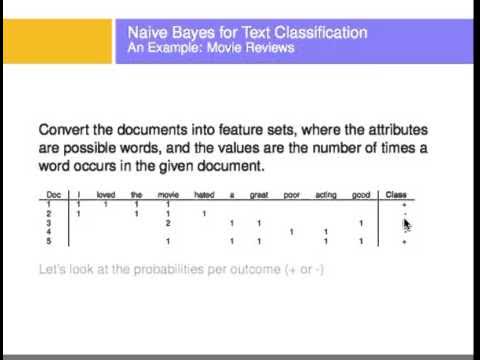Klasifikasi dengan Algoritma Naive Bayes Classifier
Summary
TLDRIn this video, Yogi explains the concept of classification using the Naive Bayes algorithm. He introduces classification as a computational technique to categorize data, based on certain criteria or features, such as determining eligibility for credit based on variables like payment history and home ownership. The video details the Naive Bayes method, including its key assumptions, advantages, and challenges, particularly its dependency assumption between attributes. Yogi also walks through practical examples, such as predicting tennis playability based on weather data and predicting pregnancy age based on various health factors, showcasing the algorithm's application in real-world scenarios.
Takeaways
- 😀 Classification is a computational technique for grouping data based on its relation to sample data, often involving predefined class labels or targets.
- 😀 Naive Bayes is a classification method based on probability and statistics, introduced by British scientist Thomas Bayes, to predict future events based on previous data.
- 😀 The core concept of Naive Bayes relies on the assumption of independence between features, which simplifies the calculation but can impact accuracy in complex cases.
- 😀 Naive Bayes classifiers work well with smaller datasets, making it efficient for situations where data is limited.
- 😀 One major advantage of Naive Bayes is that it’s simple to implement and has a proven track record of good performance in classification tasks.
- 😀 A drawback of Naive Bayes is that the assumption of independence among variables reduces accuracy, especially when there are many correlated features.
- 😀 In Naive Bayes, the classification process involves calculating the conditional probability for each class label and comparing the likelihood of different outcomes.
- 😀 The script uses a tennis game prediction example, where classification is based on factors like outlook, temperature, humidity, and wind conditions to determine if someone will play tennis.
- 😀 The Naive Bayes calculation involves evaluating the likelihood of different conditions (e.g., sunny, cool, humid) based on prior observations to predict whether someone will play tennis.
- 😀 Another example discusses predicting pregnancy age based on factors like age, blood pressure, number of babies, and medical history. The goal is to classify the pregnancy as normal, preterm, or post-term.
- 😀 The script highlights the importance of calculating probabilities for each condition and comparing them to determine the most likely outcome for classification tasks.
Q & A
What is classification in data analysis?
-Classification is a technique used to categorize data into classes or labels based on certain features. It involves grouping data based on predefined criteria, like classifying whether someone qualifies for a credit loan based on factors like installments and home ownership.
How does Naive Bayes classification work?
-Naive Bayes classification works by applying Bayes' Theorem, which calculates the probability of different classes based on given data. It assumes that the features (attributes) are independent, which simplifies the computation but may reduce accuracy when features are correlated.
What is Bayes' Theorem?
-Bayes' Theorem is a mathematical formula used to compute the probability of a hypothesis (class) given some evidence (features). It combines prior knowledge with new data to update the probability of different classes.
What does the term 'Naive' refer to in Naive Bayes?
-The 'Naive' in Naive Bayes refers to the assumption of independence among the features. It assumes that each feature contributes independently to the classification, which simplifies calculations but can be a limitation when features are actually correlated.
What are the key advantages of Naive Bayes?
-Naive Bayes has several advantages: it requires a small amount of training data, it is simple and easy to implement, and it often provides good results for many real-world problems. It is particularly effective when dealing with small datasets.
What are the main disadvantages of Naive Bayes?
-The main disadvantage of Naive Bayes is the independence assumption between features. If the features are highly correlated, the algorithm's performance may suffer, leading to lower accuracy.
Can Naive Bayes be used for large datasets?
-While Naive Bayes works well with small datasets, it can also be applied to large datasets. However, its accuracy may decrease if there are many highly correlated features, as the independence assumption doesn't hold in such cases.
What is the first step in applying Naive Bayes classification?
-The first step is to calculate the prior probability for each class. This represents the likelihood of each class occurring based on the dataset, before considering any features or evidence.
How does Naive Bayes handle feature dependencies?
-Naive Bayes assumes that all features are independent of each other. This assumption allows for simpler calculations but may cause problems when features are actually dependent, potentially reducing the accuracy of the classification.
What is an example of using Naive Bayes for classification?
-An example is predicting whether someone will play tennis based on weather conditions. The features such as outlook, temperature, humidity, and wind are considered to calculate the probability of playing tennis or not, and the most probable outcome is chosen.
Outlines

This section is available to paid users only. Please upgrade to access this part.
Upgrade NowMindmap

This section is available to paid users only. Please upgrade to access this part.
Upgrade NowKeywords

This section is available to paid users only. Please upgrade to access this part.
Upgrade NowHighlights

This section is available to paid users only. Please upgrade to access this part.
Upgrade NowTranscripts

This section is available to paid users only. Please upgrade to access this part.
Upgrade NowBrowse More Related Video

Naive Bayes dengan Python & Google Colabs | Machine Learning untuk Pemula

Text Classification Using Naive Bayes

Naive Bayes, Clearly Explained!!!

Tutorial Klasifikasi Algoritma Naive Bayes Classifier dengan Python - Google Colab

Naïve Bayes Classifier - Fun and Easy Machine Learning

SKLearn 13 | Naive Bayes Classification | Belajar Machine Learning Dasar
5.0 / 5 (0 votes)